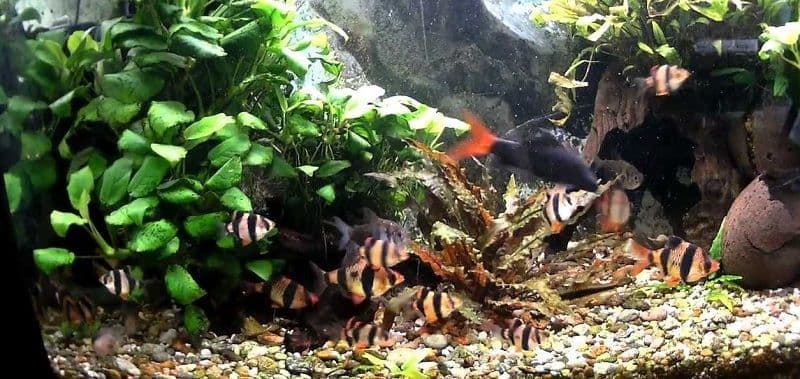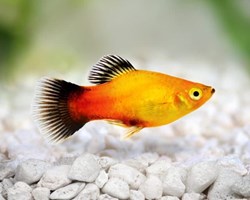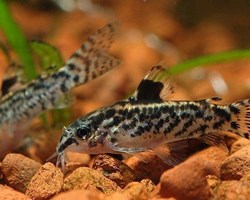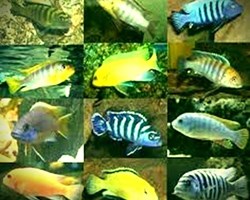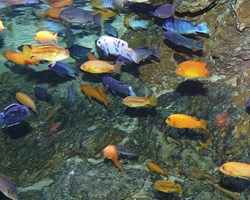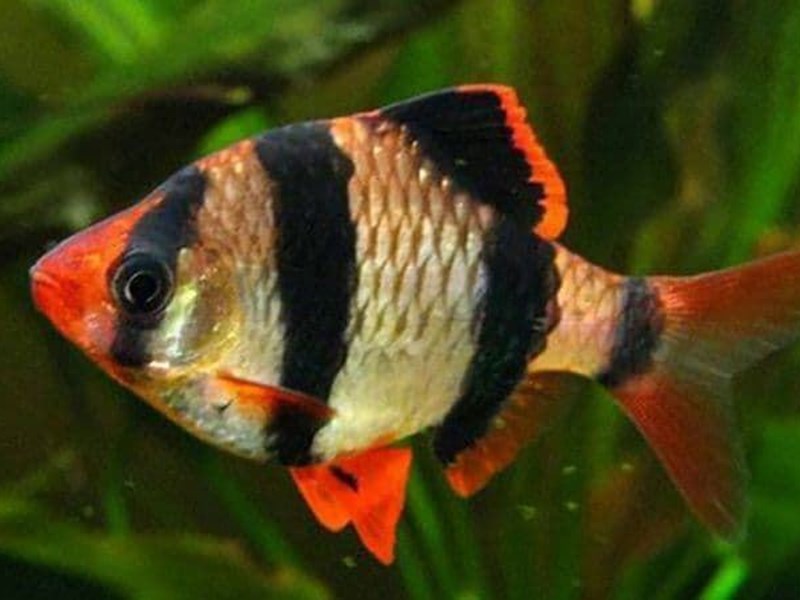
DESCRIPTION OF THE TIGER BARB:
Scientific name: Puntius Tetrazona, Barbus Tetrazona.Common name: Tiger Barbel, Banded Barbel, Sumatran Barbel, Tetrazona Barbel.Aquarium size: 100 liters
Temperament: Aggressive
Temperature: 23ºC to 28ºC
pH: 6.5 and 7
Diet: Omnivore
Length: 7 cm.
The Tiger Barbel, also known by its Latin scientific name, Puntius Tetrazona, is a very popular cyprinid, perhaps the most commercialized of all the Barbus from the islands of Sumatra and Borneo.
The reason is quite simple, it is a very resistant fish with a fairly intense color, which offers great showiness in a community aquarium.
The Puntius tetrazona (Bleeker, 1855) is one of the most frequent species in freshwater aquariums.
It really is a very hardy species that meets all the requirements for the beginner's aquarium.
Despite its beautiful coloration and its adaptability to the aquarium, it presents the difficulty with its temperament.
Its shape is that of a swimming species with its mouth, slightly protractile, placed in the middle zone, indicating its feeding habits in the middle zone of the water column.
It has cycloid scales, it does not have an adipose fin, which allows it to be distinguished from the Characins.
It has two small barbels at the corner of its mouth.
The tetrazone specification refers to the four dark vertical bands that serve as camouflage.
The first one concealing the eye and the last one at the base of the caudal fin.
They are very active and fast-swimming fish, which can annoy and nibble at other much slower fish.
In their adult state they do not exceed 7 centimeters in length.
They show a laterally flattened morphology, being wider in their central part: rhomboids.
The most commercialized species is the pink one, with four vertical black stripes, with the dorsal fin also black and with a somewhat paler rim.
The pelvic fins are black in its central part, transparent at the base of the fin and at its tip.
Apart from the “traditional” species, it is also possible to find other variants, such as the albino, green or moss-green Tiger Barbel.
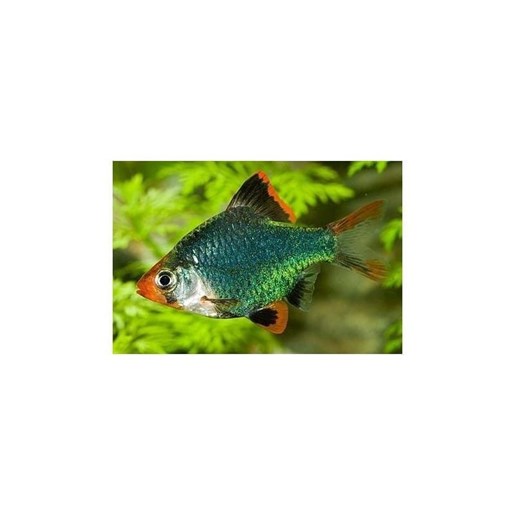
and Golden Tiger Barbel.
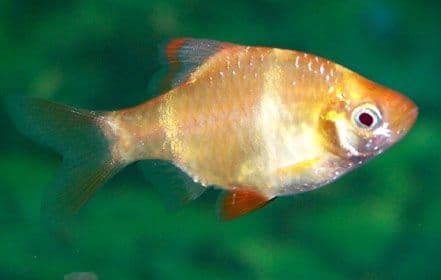
GOLDEN TIGER BARB.
Other varieties are available, such as black or coral marble.
It is difficult to distinguish the male Tiger Barbel from the female.
The most obvious difference is that the male is slimmer, smaller and thinner, with a more intense coloration than the female.
It seems that the part of the front part of the head of the males, in the original coloration, is more orange than in the females.
FOR BETTER CARE OF THE TIGER BARB IT IS CONVENIENT TO KNOW WHERE THEY COME FROM AND HOW THEY LIVE:
The Tiger Barbel is endemic to the island of Sumatra, although there are also records of sightings on the island of Borneo.
Currently they can be found in other locations around the globe, such as Singapore, Australia, the United States or Colombia, but their origin is not natural, they are the product of releasing specimens into nature.
Its natural habitat is rivers and streams, with clear water, a substrate of sand and rocks, preferably with abundant vegetation.
The tiger barbel belongs to the Cyprinidae family (Cyprinidae) native to East Asia.
The Sumatran barbel is native to the Malay Peninsula, islands of Sumatra and Borneo, as well as some areas of Thailand.
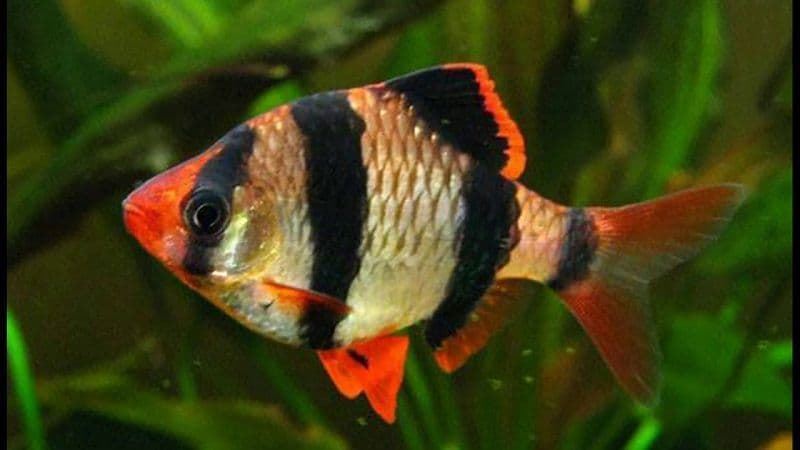
THE BEST CONDITIONS OF AN AQUARIUM FOR YOUR TIGER BARB:
We need an aquarium of about 100 liters, to maintain a small school of between 6 and 10 specimens, so that it does not disturb other species too much.
They prefer aquariums with a substrate of sand or pebbles in dark tones, with good free spaces to swim, but at the same time with adequate cavities to hide.
They are fish that consume a large amount of oxygen due to their constant and frenetic activity, so the aquarium must have a good filtering and oxygenation system.
The quality of the water must be maintained in the following parameters:
- Temperature between 23ºC and 28ºC.
- pH 6.5 to 7.
- dH less than 10º.
It adapts quite easily to multiple water characteristics, although it was originally soft water, between 5 and 10 Gh, with a slightly acidic pH.
In the aquarium it can be kept in both acidic and alkaline waters without problem as long as it is properly acclimatized.
The appropriate temperature is around 25ºC, which allows the animal to develop its maximum activity.
Keeping it in this range, even though it supports higher temperatures, allows it to be increased later if we want to promote breeding or treat any disease.
The appropriate aquarium is the one planted on the sides and bottom, leaving free space to swim because it is a very active species.
Properly fed, they will not touch the leaves of plants, not even genera such as Cabomba or Myriophyllum.
His temperament is quite belligerent.
It is a kind of school that spends the day chasing each other.
If we keep it in a group of 6-8 individuals, these chases are usually carried out among themselves, forgetting the rest of the aquarium inhabitants.
They are fish that tend to nibble on the developed fins of slow-swimming species such as guppies, bettas, and scalars. Repeated bites will lead to bacterial infections and the appearance of cottony mold.
It is advisable not to risk keeping them together even if we have a large aquarium.
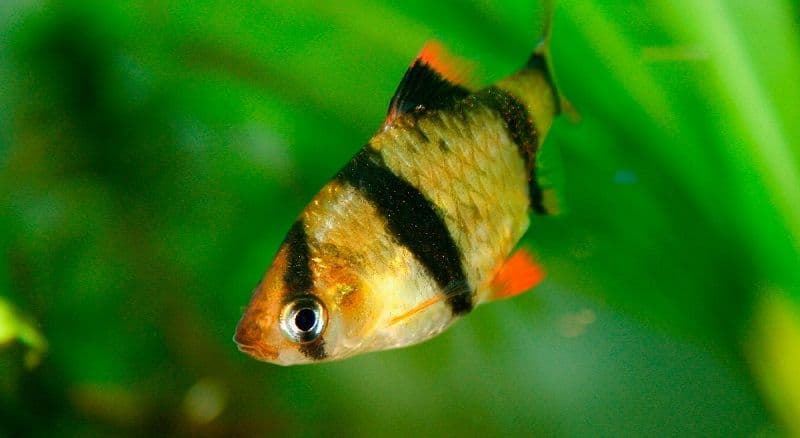
THE FEEDING OF YOUR TIGER BARBELL:
The Puntius Tetrazona is omnivorous, it consumes everything: dry food, frozen food, flakes, but without a doubt what it likes most is small live prey, so we can provide artemia raised by ourselves.
It seems that they are always hungry, so you have to feed them at least twice a day.
Although we can feed them indefinitely with prepared dry food, the ideal is to give them a feed of dry food, and another with live or natural food: brine shrimp, daphnia, tubifex, mosquito larvae or frozen food.
THE BEHAVIOR AND COMPATIBILITY OF THE TIGER BARB IS VERY IMPORTANT FOR ITS CARE:
They are fish in constant movement, they are very active and excellent swimmers.
Occasionally chases quieter species and nips at their fins, especially when tank is overcrowded and space is limited.
This aggressive attitude is minimized if we raise them in groups of 6 to 10 individuals.
It is not an ideal companion for shy or slow species, but they can be kept with other cyprinids of similar size and with fish with which they do not share space.
They could coexist with Tetras and Cobitids, which occupy a different space in the aquarium.
The fish compatible with Tiger Barbel are:
- Mosquito fish.
- Ax Fish.
- Botia Clown.
- Goldfish.
- Zebra fish.
- Chinese Neon Fish.
- Silver Dollar Fish.
- Kribensis fish.
- Molly.
- Female betta fish.
- Telescope.
- Otocinclus.
- Nun fish.
- Molly fish.
- Pearl Gourami.
- Platy.
- Guppies.
- Drunken Fish.
- Harlequin fish.
- Ramirezi.
- Cherry Barbel.
- Guppy Endler.
- Apple Snail.
- Neon tetra fish.
- Rasbora Galaxy.
- Corydora fish.
- Ancistrus.
- Bubble eyed fish.
Fish compatible with restrictions:
- Rainbow Fish.
- Koi carp.
- Paradise fish.
- Killi fish.
- Scalar Fish.
THE REPRODUCTION OF THE TIGER BARB:
It is not too complicated to reproduce the Tiger Barbel in the aquarium, as long as we provide it with the right conditions.
The ideal temperature to favor reproduction is around 27ºC, the aquarium must be spacious, well stocked with plants and with a protection grid for the eggs that end up at the bottom.
They usually lay between 100 and 400 eggs, which are deposited among the vegetation.
Once spawning occurs and the eggs have been fertilized, the adult specimens must be removed to prevent the eggs from being eaten.
Hatching occurs at 36 hours.
The fry have food reserves in their yolk sac.
Once it is reabsorbed, feeding should be started with brine shrimp nauplii, infusoria and suitable fingerling feed.
The moment of spawning is preceded by the male racing after the female.
These races are different from the usual ones because their objective is not the caudal fin but the cloaca area.
The closer the female is to the clutch, the more the male advances with his touches until he reaches her height to press the female's flank.
In this way it helps to release the eggs while fertilizing them.
The clutches revolve around the 200 eggs that hatch between 36 and 48 hours.
Fingerlings have a low mortality rate but developmental sizes should be controlled as they cannibalize each other.
The water conditions for breeding are slightly different from those for maintenance.
Temperature between 28 and 30º, pH between 6 and 7 degrees, hardness less than 10 Gh.
